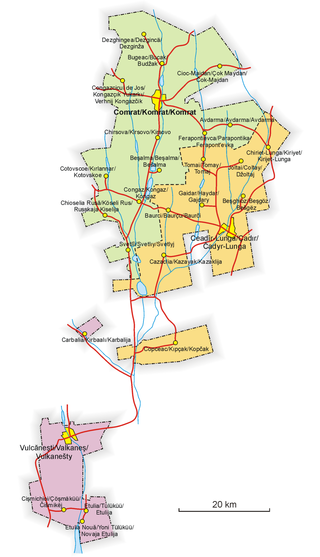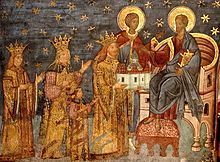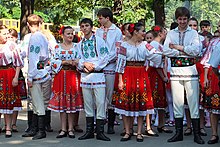The history of Moldova can be traced to the 1350s, when the Principality of Moldavia, the medieval precursor of modern Moldova and Romania, was founded. The principality was a vassal of the Ottoman Empire from 1538 until the 19th century. In 1812, following one of several Russian–Turkish wars, the eastern half of the principality, Bessarabia, was annexed by the Russian Empire. In 1918, Bessarabia briefly became independent as the Moldavian Democratic Republic and, following the decision of the Parliament, united with Romania. During the Second World War it was occupied by the Soviet Union which reclaimed it from Romania. It joined the Union as the Moldavian ASSR, until the dissolution of the USSR. In 1991 the country declared independence as the Republic of Moldova.

Bessarabia is a historical region in Eastern Europe, bounded by the Dniester river on the east and the Prut river on the west. About two thirds of Bessarabia lies within modern-day Moldova, with the Budjak region covering the southern coastal region and part of the Ukrainian Chernivtsi Oblast covering a small area in the north.

Moldavia is a historical region and former principality in Central and Eastern Europe, corresponding to the territory between the Eastern Carpathians and the Dniester River. An initially independent and later autonomous state, it existed from the 14th century to 1859, when it united with Wallachia as the basis of the modern Romanian state; at various times, Moldavia included the regions of Bessarabia, all of Bukovina and Hertsa. The region of Pokuttya was also part of it for a period of time.

The culture of Romania is an umbrella term used to encapsulate the ideas, customs and social behaviours of the people of Romania that developed due to the country's distinct geopolitical history and evolution. It is theorized that Romanians and related peoples were formed through the admixture of the descendants of Roman colonists and the indigenous Paleo-Balkanic people who were subsequently Romanized.

The Moldavian Soviet Socialist Republic or Moldavian SSR, also known as the Moldovan Soviet Socialist Republic, Moldovan SSR, or simply Moldavia or Moldova, was one of the 15 republics of the Soviet Union which existed from 1940 to 1991. The republic was formed on 2 August 1940 from parts of Bessarabia, a region annexed from Romania on 28 June of that year, and parts of the Moldavian Autonomous Soviet Socialist Republic, an autonomous Soviet republic within the Ukrainian SSR.

Gagauzia or Gagauz-Yeri, officially the Autonomous Territorial Unit of Gagauzia (ATUG), is an autonomous territorial unit of Moldova. Its autonomy is intended for the local Gagauz people, a Turkic-speaking, primarily Orthodox ethnic group.
The Gagauz are a Turkic ethnic group native to southern Moldova and southwestern Ukraine (Budjak). Gagauz are mostly Eastern Orthodox Christians. The term Gagauz is also often used as a collective naming of Turkic people living in the Balkans, speaking the Gagauz language, a language separated from Balkan Gagauz Turkish.

Budjak, also known as Budzhak, is a historical region that was part of Bessarabia from 1812 to 1940. Situated along the Black Sea, between the Danube and Dniester rivers, this multi-ethnic region covers an area of 13,188 km2 (5,092 sq mi) and is home to approximately 600,000 people. The majority of the region is now located in Ukraine's Odesa Oblast, while the remaining part is found in the southern districts of Moldova. The region is bordered to the north by the rest of Moldova, to the west and south by Romania, and to the east by the Black Sea and the rest of Ukraine.

Moldovans, sometimes referred to as Moldavians, are a Romanian-speaking ethnic group and the largest ethnic group of the Republic of Moldova and a significant minority in Romania, Italy, Ukraine and Russia. There is an ongoing controversy, in part involving the linguistic definition of ethnicity, over whether Moldovans' self-identification constitutes an ethnic group distinct and separate from Romanians, or a subset. The extent of self-identification as Romanians in the Republic of Moldova varies.
The names of Moldavia and Moldova originate from the historical state of Moldavia, which at its greatest extent included eastern Romania, Moldova, and parts of south-western and western Ukraine.

The Bessarabian Bulgarians are a Bulgarian minority group of the historical region of Bessarabia, inhabiting parts of present-day Ukraine and Moldova.

The history of Gagauzia dates back to ancient times. The larger area, known as Bessarabia, previously the eastern half of the Principality of Moldavia, was annexed by the Russian Empire in 1812. The Gagauz have been ruled by the Russian Empire (1812–1917), Romania, the Soviet Union, and Moldova.

Moldovan cuisine is a style of cooking related to the people of Moldova. It consists mainly of ingredients such as various meats, potatoes, cabbage, and a variety of cereal grains. The local cuisine is very similar to Romanian, and also draws inspiration and elements from other cuisines in the region, including Greek, Polish, Ukrainian, and Russian, with a great influence left by the Ottoman cuisine.

Romanian nationalism is the nationalism which asserts that Romanians are a nation and promotes the cultural unity of Romanians. Its extremist variation is Romanian ultranationalism.

A controversy exists over the national identity and name of the native language of the main ethnic group in Moldova. The issue more frequently disputed is whether Moldovans constitute a subgroup of Romanians or a separate ethnic group. While there is wide agreement about the existence of a common language, the controversy persists about the use of the term "Moldovan language" in certain political contexts.

Ismail County was a county (județ) of Romania between 1925 and 1938 and between 1941 and 1944, in Bessarabia, with the capital city at Ismail. It was also a county of Moldavia between 1856 and 1859, and of the Principality of Romania between 1859 and 1878, in Southern Bessarabia.

Literature of Moldova comprises the literature of the principality of Moldavia, the later trans-Prut Moldavia, Bessarabia, the Moldavian Autonomous Soviet Socialist Republic, the Moldavian Soviet Socialist Republic, and the modern Republic of Moldova, irrespective of the language. Although there has been considerable controversy over linguistic identity in Moldova, the Moldovan and Romanian languages are virtually identical and share a common literary history. Moldovan literature, therefore, has considerable overlap with Romanian literature.

Western Moldavia, also called Romanian Moldavia, or simply just Moldova is the core historic and geographical part of the former Principality of Moldavia situated in eastern and north-eastern Romania. Until its union with Wallachia in 1859, the Principality of Moldavia also included, at various times in its history, the regions of Bessarabia, all of Bukovina, and Hertsa; the larger part of the former is nowadays the independent state of Moldova, while the rest of it, the northern part of Bukovina, and Hertsa form territories of Ukraine.

Cahul County was a county of the Kingdom of Romania between 1925 and 1938 and between 1941 and 1944, in the historical region of Bessarabia, the successor of Cahul County.

Greater Moldova or Greater Moldavia is an irredentist concept today used for the credence that the Republic of Moldova should be expanded with lands that used to belong to the Principality of Moldavia or were once inside its political orbit. Historically, it also meant the unification of the lands of the former principality under either Romania or the Soviet Union. Territories cited in such proposals always include Western Moldavia and the whole of Bessarabia, as well as Bukovina and the Hertsa region; some versions also feature parts of Transylvania, while still others include areas of Podolia, or Pokuttia in its entirety. In its most post-Soviet iterations, "Greater Moldova" is associated with a belief that Moldovans are a distinct people from Romanians, and that they inhabit parts of Romania and Ukraine. It is a marginal position within the Moldovan identity disputes, corresponding to radical forms of an ideology polemically known as "Moldovenism".























